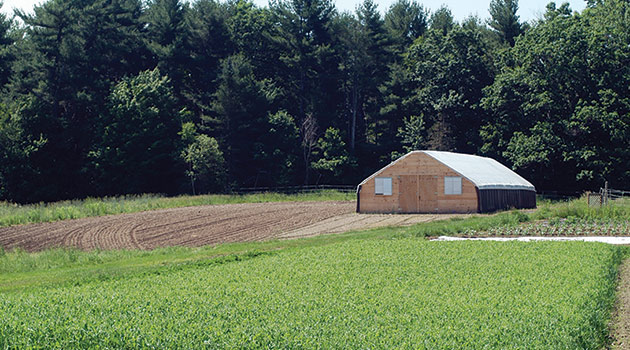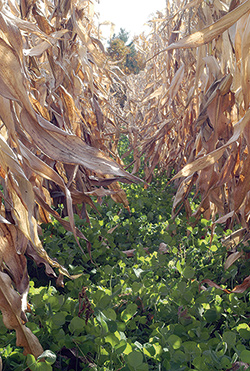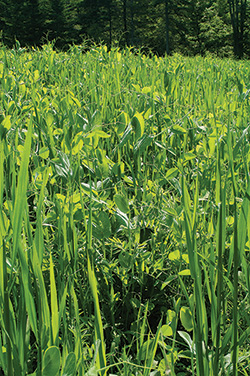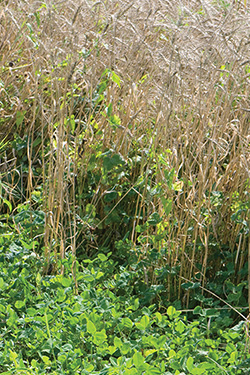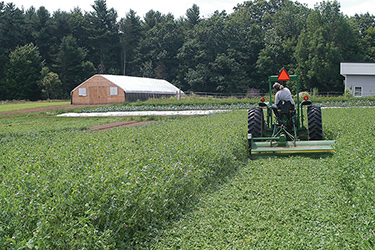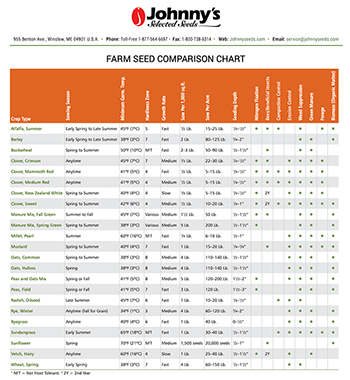Spring Cover Cropping
Develop a plan for springtime cover cropping with these simple guidelines
by Eric Venturini, Executive Director, Wild Blueberry Commission of Maine; former Education Coordinator, Johnny's Selected Seeds
Planning for Spring
1 • Define Your Goals
2 • Identify Your Spring Cover-Cropping Window
3 • Check Your Equipment
4 • Factor in Location
5 • Test Case
LEARN MORE
Here at Johnny's Research and Development Farm in Albion, Maine, cover crops are a common sight throughout the year, but what that picture looks like in spring differs from other times of the year — as well as from field to field with crop rotations.
Medium Red Clover, while most often sown in spring, is also often under-seeded into knee-high corn to provide a winter cover that regrows the following spring.
In other fields, you might see winter rye and hairy vetch growing through a protective barrier of winter-killed field pea, crimson clover, and ryegrass — components of our Fall Green Manure Mix.
When used appropriately, these and other covers can help farmers and gardeners improve soil tilth, boost soil microbial life, fix nitrogen into the soil, scavenge and hold nutrients, alleviate compaction, suppress weeds, and more. Depending on your situation the picture will differ on your land, too.
Importantly, however, a cover crop whatever the region, field, or season will not confer these benefits without proper planning and care. In fact, a poorly managed cover crop can do more harm than good.
Here we outline the basic considerations for putting your own spring cover-crop plan in place.
1 • Define Your Goals
Spring Green Manure Mix:
- Provides early-season soil cover
- Adds organic matter to the soil
- Suppresses weeds emerging through a winter-killed cover crop or from land left bare over winter
Learn more about Spring Green Manure Mix…
Considering the long list of potential benefits, what are your particular cover-cropping goals for the upcoming spring and summer? Do you primarily want to control weeds? Are you trying to supply some of the nitrogen requirements of a cash crop?
From the many functions a cover crop can serve, try to pick just a few to accomplish with any given cover crop planting. Each variety or mix has particular strengths and limitations, and should be chosen based on your desired outcome.
For example, our Spring Green Manure Mix, which contains field peas, oats, and hairy vetch, can help control weeds, fix nitrogen, and increase organic matter. The fast-growing oats get a head-start on weeds, and the sprawling habits of the field peas and vetch help to close the canopy, starving weeds of light and preventing weed seed germination. Two of the three varieties in the mix, field peas and hairy vetch, are legumes. They have the ability to convert otherwise unavailable atmospheric nitrogen to an available form in the soil that's ready for crop utilization.
When a cover of Spring Green Manure Mix is terminated and incorporated into the soil, the nitrogen and other nutrients break down and become available to other plants — namely, your cash crop — and can reduce the amount of fertilizer required.
2 • Identify Your Cover-Cropping Window
When will you plant your cover crop? When will you terminate it? Timing should play a key role when determining the best cover-cropping option for you. While many cover crops can be planted successfully at different times of the year, they will often perform different functions when planted in different time slots.
For example, spring-planted oats provide an excellent, fast-growing green manure that can be turned into the soil prior to planting a main-season crop. Planted in late summer, oats will hold the soil in place throughout the winter, and the winter-killed oat stubble will provide thick mulch into the early spring.
Maybe you are planning an early-season crop of spinach and a late-summer planting of onions for overwintering. In this case, your cover-cropping window falls not in spring but between early July and mid August. Depending on your cover-cropping goals, buckwheat could be a great choice for a short, midseason window. It is a fast-growing, heat-loving green manure that provides an abundance of nectar for bees and other beneficial insects. (Tip: If growing buckwheat for honey production or to help support beneficial insects, be aware that the plant shuts off its nectar production at about noon each day.) In addition, buckwheat's broad leaves quickly close the canopy to help suppress weed growth.
Many growers sow early-season cover crops to fix nitrogen, provide early season weed control, and add organic matter to the soil prior to planting fall-harvest crops, such as squash, pumpkins, carrots, and brassicas. Here again, the Spring Green Manure Mix is an excellent early-season choice that will fulfill these goals. It includes field peas, oats, and hairy vetch. The oats germinate first, in soil temperatures as low as 38°F (3.3°C). As spring progresses and the soil continues to warm, the field peas will germinate and grow, followed by the hairy vetch. By inoculating the seed at planting time with Garden Combination Inoculant or Pea, Vetch & Lentil Inoculant, for example, you can facilitate the development of bacteria-filled, nitrogen-fixing nodules on the roots of the peas and hairy vetch in the mix, to enrich your soil.
3 • Equipment Check-up Time
Efficiently planting, managing, and terminating your cover crop will require appropriate equipment in good working condition. Talk with other growers in your area, draw on the expertise of the people at your local Cooperative Extension Service, and benefit from workshops and all available resources. Set up a regular maintenance schedule to allow time for tinkering. All this planning ahead will allow you to budget resources accordingly — and to get your spring crop in when conditions are favorable.
4 • Factor in Your Location
It is important to understand which varieties do, and do not, perform well in your region.
Many clovers, for example, can be difficult to grow in arid climates. Red clover, crimson clover, and white clover perform best in the eastern half of the U.S., and along the Pacific Coast.
Sudangrass, on the other hand, loves heat, tolerates drought, and will perform well in all but the coolest, wettest climates.
In wet and heavy soils, by contrast, oats are more tolerant than many other cover crops and can make a good, quick-growing early choice.
Other varieties need to be planted at different times in different regions for the best results.
In the southeastern United States, sweet clover is used as a fall-planted biennial, whereas it is planted in most other parts of the country in the spring, and flowers the following summer.
5 • Test It Out
One recent December day, a customer called to ask for a cover crop recommendation. We asked them where they lived, what their time window was, and what their goals were.
Their goals: Erosion control, green manure, quick growth.
Window: 40–50 days. Planted in early spring; terminated early to mid-season.
Location: Tennessee; Zone 7.
A number of our cover crop options could fulfill the needs of this grower. Based on their answers, here are the various options we recommended they try, and why:
- Hairy vetch can be planted early in the spring, will act as a green manure, and hold the soil, and, because it is a legume, it will also fix nitrogen into the soil.
- Barley is another good choice. It can be planted when soil temperature is as low as 38°F (3.3°C), grows very quickly, will hold the soil, and works well as a green manure.
- Oats are another great, fairly fast-growing spring option that would fulfill the grower's needs.
- Better erosion control, and also weed suppression, can often be had by planting multiple types of cover crops together, rather than just a single variety. Provided the soil has warmed enough by the time the grower plants, this is another case where our Spring Green Manure Mix would work very well.
- Other options could include buckwheat (again, if the soil is warm enough), ryegrass, and crimson clover.
When deciding which spring cover crops are most appropriate for you, you've considered your cover-cropping goals, your window of opportunity, equipment needs and maintenance, and your growing region. By clearly identifying your primary goals, timing, and varieties suited to your region, you can put a spring cover-cropping plan in place that fulfills your needs in the upcoming season.
More Resources
Refer to the following resources for additional guidance on spring cover crop planning.
- Top 10 Farm Seed Uses & Benefits • Charticle
- Johnny's Farm Seed & Cover Crops • Comparison Chart • PDF
- Cover Crops to Plant in Early Spring • Cornell University College of Agriculture & Life Sciences
- Cover Crops & Green Manures • New England Vegetable Management Guide • UMass Amherst
- Cover Crops for the Intermountain West • Natural Resources Conservation Service • Boise, ID
- Cover Crops for Home Gardens• OSU Extension Catalog
- Cover Crops for Home Gardens West of the Cascades • WA State Univ Ext Fact Sheet • FS111E
- Spring Management of Cover Crops • UMN Ext
- Overview of Cover Crops & Green Manures • ATTRA, the National Sustainable Ag Info Service
- Cover Crops: An Effective Weed Control for Organic Vegetable Production • American Vegetable Grower News


